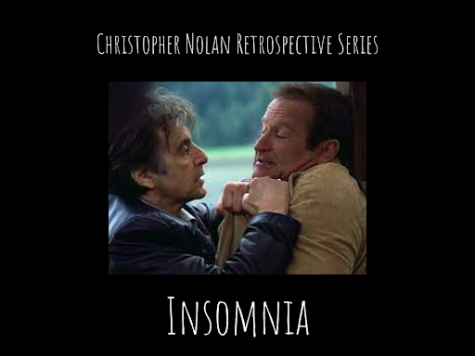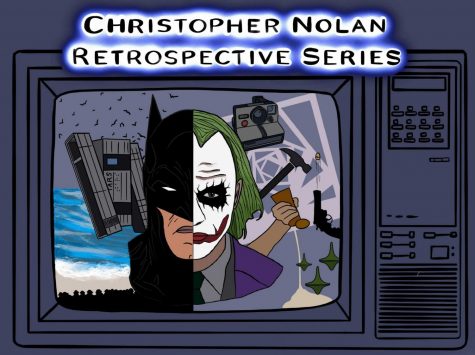Christopher Nolan Retrospective Series: Part Two, ‘Memento’

‘Memento’ was Christopher Nolan’s first breakout movie, and a reunion of ‘The Matrix actors’ Carrie-Anne Moss and Joe Pantoliano. Graphic by Josh Shippen.
This piece is part two of a six-part series. Read the first installment here.
Out of the 11 films that Christopher Nolan has made, there are five that I consider to be masterpieces. Memento is definitely one of them. Memento was released to general audiences on March 16, 2001, and follows the life of Leonard Shelby (Guy Pearce), a man filled with revenge towards the man that raped and killed his wife. Leonard has been desperately searching for his wife’s killer, known simply to be John G.
However, one looming obstacle stands in Leonard’s way. Leonard Shelby has no short-term memory. His wife’s murderer, or possibly his accomplice, struck him over the head and gave him anterograde amnesia, leaving him with the inability to make new memories. Imagine the last thing you remember being the killing of your wife every day for the rest of your life. It’s a scary thought.
Though this film is the second Christopher Nolan installment to feature non-linear storytelling, Nolan certainly perfected his style since Following. Memento follows two converging storylines. The portion filmed in black and white starts at the chronological beginning of the story and moves forward while the colored portion starts at the end and goes backwards until the stories finally meet in the middle for the conclusion. The scenes alternate between black and white and colored about every three to five minutes. Despite the seemingly complex and fast-paced timelines, the film is surprisingly easy to follow.
The least confusing way to explain the plot is to go through each sequence separately. I’ll start with the black and white timeline. Leonard is seen in a hotel room talking with an anonymous figure on the phone. As their conversation progresses, Leonard explains his past including the story of his wife’s killing, the story of Sammy Jankis, the only other man who shared his condition, and how he is able to re-orient himself using tattoos that will lead him to his wife’s killer. He also explains his use of Polaroid photos with notes on them as a way to keep track of his current situation.
Leonard’s story of Sammy Jankis is as follows: Sammy Jankis was a man that Leonard was investigating back when he worked in insurance claims. Leonard’s goal was to evaluate whether Sammy Jankis’s condition was physical or psychological. Ultimately, he determined that the condition was physical, and would grant the claim to Jankis and his wife, suggesting that the problem was not “in his head” because although Sammy showed no examples of recognizing tests or patterns, he had a look of recognition whenever Leonard came to visit. Sammy’s wife however was not ready to give up. She would conduct intense and even cruel tests on Sammy to try and break his condition and return Sammy to normal. In a desperate bid to get her husband back, Sammy’s wife had Sammy inject her with insulin shots in very quick succession, hoping that eventually, Sammy’s memory would be jogged. Sammy did not stop administering the drug, and Sammy’s wife was subsequently sent into a coma and killed.
A big part of the end reveal is Teddy telling Leonard that Sammy was a substitution Leonard made for himself to cope with his wife’s death, but in that case, how do we determine if the condition is physiological or psychological? I think there are two obvious tells that Leonard’s condition is psychological. First is that Leonard identifies Sammy’s condition as in the mind by identifying that he has a look of recognition every time they meet. However, if you look closely every time Leonard is meeting a new person, be it Teddy or Natalie, he always has that same look of recognition. The second tell that I caught is this. How does Leonard even know he has this condition? Would he not wake up every five minutes and always wonder what was going on and why the last thing he remembered was his wife’s murder? It’s not like the guy had a big tattoo reading ‘I have Anterograde Amnesia’ on his chest. There’s also very subtle visual tells. There are flashback scenes of Sammy in a mental institution towards the end of the film, and in an extremely brief cut we see Leonard in that same mental institution insinuating one of two realities. This is all in Leonard’s head, or Leonard escaped in order to find his wife’s killer. I tend to not really go for the ‘it was all a dream’ stories so if this is the correct interpretation, I’d be inclined to guess that it’s the second option.
Another big reason that I tend to not lean towards the physical side is because no matter what, Leonard is always able to re-orient himself very quickly using conditioning and the clues he gives himself. Not even Sammy, who he did deem to be a psychological case, ever had that much control of what was going on around him.
I don’t think Leonard is faking, and I want to make that clear. There’s a difference between your mind lying to itself to survive and deliberately trying to screw everyone over by faking a memory condition. I don’t think that the film is trying to communicate that Leonard is a con man because there are too many instances where Leonard references the fact that Sammy did love his wife. If Sammy’s and Leonard’s stories are assumed to be synonymous then we can conclude that Leonard’s condition is legitimate.
With that said about Leonard’s relationship with his wife, one aspect I am never sure of is the role of the wife. In all flashbacks we get of her she never looks happy, in fact she looks quite upset most of the time. In the only verbal sequence we get with her, she and Leonard argue about a book, with Leonard questioning if she’s actually read it a thousand times and her countering that it’s a good book. Even though there’s nothing especially angry or stern about their dialogue, there is clearly some sort of strain between them. Additionally, to jump ahead to when Leonard is killing Jimmy Grantz, Jimmy is pleading with Leonard; “What do you want?” Leonard screams “I want my life back.” No mention of his wife is made. This means that either Leonard and his wife had a tense relationship, or that the flashbacks occur after the incident and that his wife’s demeanor can be explained by her coping with her husband’s condition. This story arc is important because people who believe Leonard had a strained relationship with his wife might also believe that Leonard was aware of the fact that he killed his wife, and would identify him as a con man. But again I will reiterate that the reason I don’t encourage this line of thought is because Leonard was always clear about the fact that Sammy Jankis did love his wife. If Sammy’s story and Leonard’s story are meant to be looked at as synonymous then I think it is safe to say that if Leonard did commit the murder, he did not do it on purpose.
One fun tidbit about this movie is that for the second time in two films, Christopher Nolan has made an early homage to his Batman trilogy. In Leonard’s town, we see that the comic book store predominantly features Batman. This has no bearing on the plot but it’s an interesting fact all the same.
Since the color reality is in reverse chronological order, it’s easier to describe it starting from the end as it’s seen in the film but at the beginning of its chronology. Leonard has begun to track John G. starting with a license plate number that he tattooed on his leg. After finding an address in his coat, he meets a woman named Natalie (Carrie-Anne Moss) at a bar, believing that she is someone who could help in his search for John G. Natalie however, is put off by Leonard because when they meet he’s wearing her boyfriend Jimmy Grantz’s clothes and driving his car. Despite this, she sees that she can use Leonard’s condition to her advantage. Natalie uses Leonard to scare away a man called Dodd in exchange for running the plate that Leonard has brought back. Natalie is incredibly manipulative towards Leonard and revels in the fact that she can berate and insult him and he won’t be able to remember any of it.
I think one of the only things that Memento does wrong is the way it includes the story of Dodd. This arc feels very much like Nolan wanted it to be an important storyline but simply had too much plot to deal with. In the end, I feel that it’s the right decision to pay less attention to Dodd but it feels like the only aspect of the film that is a little bit sloppy.
Leonard soon learns that Natalie is not the only person willing to help. Leonard soon meets cop Teddy (Joe Pantoliano). Teddy is mistrustful of Natalie and uses every opportunity to keep Leonard away from her. Teddy even guides Leonard to the discount motel where Leonard stays for the duration of the film. Teddy is seemingly the only friend Leonard has during the film, but he is also quite deceitful as will be revealed in the finale. As Leonard begins to find more clues about John G. and gets information about the man from the plate that Natalie ran, Leonard discovers that John G. is John Edward Gammell, and that John Edward Gammell is the full name of Teddy. Filled with rage, Leonard drives with John G. to an abandoned house and shoots him in the head.
I think it’s important not to hate the character of Natalie, although it’s extremely easy to do so. Imagine a man walking into your bar wearing your missing boyfriend’s clothes and driving his car. Imagine knowing this man was working with a cop who might be on the tail of your missing boyfriend’s drug bust. Most people would react very strongly in this situation. I don’t think Natalie’s strong reaction is any worse than the way Teddy uses Leonard to kill John G. Natalie’s character, is a very easy character to understand, if not one we will side with.
And finally, the conclusion as seen in the final black and white sequence, Leonard is prompted by the anonymous caller to go to the abandoned house where he first meets Teddy. Teddy explains that he has tracked down “John G.,” the full name of Jimmy Grantz. Leonard strangles Jimmy to death, but as Leonard commits the murder, he begins to doubt that Jimmy is the real John G. Leonard expresses his doubt to Teddy who presses that Jimmy Grantz is in fact the real John G, but Leonard remains convinced that he killed the wrong man. And now, the truth finally comes out. Or at least we think it does.
Teddy reveals that in fact, Jimmy Grantz was not John G., and that Leonard had in fact succeeded in killing John G. a year ago, having a polaroid to prove it. The chilling truth that Teddy reveals is that Leonard’s wife actually survived the attack but could not cope with her husband’s condition. Teddy tells Leonard that Sammy was a fraud and a con man, and goes so far as to say he didn’t even have a wife. Leonard’s wife was the one receiving the insulin shots, and Leonard was the man responsible for her death. Sammy’s story was simply a story Leonard created for himself to cope with the tragic act he had committed on his wife. Filled with dread and anger, Leonard escapes Teddy and gives himself enough clues to track down Teddy and kill him thinking that he is the John G. he is looking for so Teddy can never reveal this horrible truth to him again.
This film leans heavily on the use of an unreliable narrator and that is what makes this twist so interesting. How are we to trust anything Teddy tells Leonard because we know Teddy is a proven liar? In that same vein, Leonard’s memory is not to be trusted either. Even leaving points of trust aside, Leonard points out in the very beginning how unreliable memory is, stating that “Memory can change the shape of a room; it can change the color of a car. And memories can be distorted”. This is our earliest indication that the information given to us by Leonard’s voice-over narration is not to be trusted. This circles back to the big question: if Leonard is not to be trusted, then who is? I think the only answer that makes sense is that the only thing we can trust are the flashbacks and what Christopher Nolan chooses to show us. Natalie and Teddy have both proved to be deceitful, and Leonard has gone to the lengths of deceiving himself if it means never knowing the horrible truth about his life.
The most obvious question from everyone who watched the movie is who’s telling the true story? Well, I don’t think anybody knows for sure. Nolan has gone on record saying that there is a definitive answer and that careful viewers will catch it, much like how we did with Inception. However, in over two decades of searching, there still is not a clear answer, so all I can tell you is what I believe.
The next questions are especially interesting. Did Leonard actually kill his wife, and how real was Sammy Jankis? I think Leonard did in fact kill his wife, and he did have the condition. In quick flashback cuts, we often see a scene of Leonard giving his wife a loving pinch, but in one cut instead of a pinch, it’s an insulin shot. As to Sammy Jankis’ story, I think Sammy Jankis did exist, and I do think Leonard investigated him, but I tend to believe that he’s a con man. I don’t think the insulin story applies to Sammy at all, and that was just a story that Leonard created to help cope with the fact that he had killed his wife.
An interesting question to consider is that of Leonard’s motivation. Because of Leonard’s condition, his only motivation to exist is to catch his wife’s killer. After that, what next? Leonard’s conditioning has clearly given him a violent instinct. Does this mean that killing has become a necessity for him? Or at the very least a need that he must feel purposeful?
If there was one thing Following did extremely well, it was creating that chilling mood and making an audience feel tension. I think Memento does even better than its predecessor at pulling this off. Memento has a very chilling score. Nolan worked with composer David Julyan to create a very synthesized score, a score that is often used as a bridge between the black and white sequences and the color sequences. The score is overall very excellent in the movie, but it’s not the most interesting listen by itself.
This was Nolan’s first instance of working with cinematographer Wally Pfister who Nolan would go on to work with on many of his films. The camera angles and overall camera work are very careful, deliberate, and well-executed.
The acting in this film is incredible across the board. Guy Pearce’s hesitant way of speaking and portrayal of a man who sometimes had no idea where he was is outstanding. Carrie-Anne Moss and Joe Pantoliano both do amazing in their respective roles as well. The screenplay is also really genius for this movie. Everything matters in this movie but none of it is covered up more than it needs to be.
I only have one major knock against Memento, and it’s kind of my knock for all Nolan films. There is no easy character to root for, and every character feels extremely cold and distant. This may actually be deliberate as the film is presenting a lot of cold ideas and scary situations, but sometimes it can be hard to stay engaged in a film if there aren’t characters I’m not connected to. It’s not a huge problem in this movie, but it will become a problem in later movies such as Dunkirk and Tenet.
There’s no question that Memento is an instant classic for the ages. Its intricate plot and flawless screenplay make it one of the most psychologically interesting films to follow. I’m going to give Memento one of the strongest recommendations I can give a film. Even if you haven’t seen the movie and read this article, go give this film a look. This is a rare movie that you can get spoiled, but still thoroughly enjoy.

Class of 2022
I write movie reviews and also write about football (NFL). In my spare time, I like to watch movies, watch football, play video games,...








